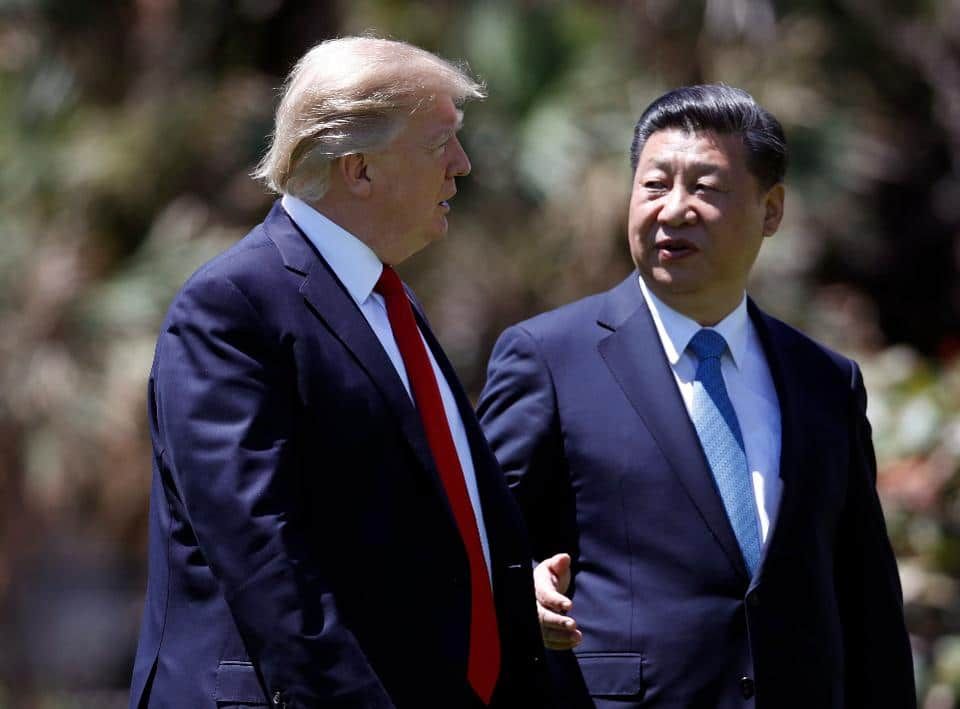

As a presidential candidate, Donald Trump denounced China for weakening its currency to steal business and jobs from Americans – “the greatest theft in the history of the world.” In office he’s been singing a different tune. First he declined to label the country a currency manipulator. And recently he told Chinese president Xi that he’d allow continued high trade deficits, in exchange for help in restraining North Korea’s nuclear ambitions.
Maybe President Trump is simply shifting his geopolitical focus from economics to the military. While the Chinese premier was visiting, he ordered the strike on the Syrian airfield and allowed the massive bomb in Afghanistan. Both were indirect messages that the United States is now prepared to act aggressively to defend its global interests. More directly, the administration sent a carrier group in February to patrol against Chinese expansionism in the South China Sea.
But there’s a better way for the government to confront China, and it plays directly into the economic nationalism that the president’s political base holds dear.
Producers and Consumers
A big reason for China’s astounding rise has been its policies favoring producers over consumers. By keeping wages low and showering companies with cheap capital, it has become a global manufacturing powerhouse. It relies on open borders in exporting to other countries, but at home it sets up a variety of restrictions against US and other foreign companies. Firms can sell, but they usually have to work with a local partner, and over time the profits – and intellectual property – usually disappear.
The U.S. tolerated these abuses up to now because of its pro-consumer tendencies. All those inexpensive Chinese goods made buyers happy, after all. And Chinese purchases of Treasury bonds helped fund the expanded American welfare state.
To meet the challenge from China, it’s time to reverse those policies. At least temporarily, we need to shift the balance back to producers. Some of that is already on track, with plans to boost spending on infrastructure and reduce corporate taxes. The new administration has also signaled its determination to fight “dumping” of low cost imports and other trade abuses. To get the most geopolitical bang for the buck, however, the Trump administration should target manufacturing.
Speeding Up the Future
That doesn’t mean industrial policy, or picking winners. Instead of favoring manufacturing as a whole, we should focus on the new wave of digital technologies that are taking factory automation to a new level. These include flexible robots, 3D printing, artificial intelligence, and the internet-of-things. All of these will help us geopolitically because they’ll shift the economics of production.
Conventional factories are all about economies of scale from huge specialized plants with intricate supply chains. China has mastered that approach, which is why it fills the shelves of Wal-Mart. But factories with the new technologies will be able to keep costs low while also achieving flexibility. They’ll have simpler supply chains, and be profitable even at only moderate volumes. So companies will set up plants close to their main customers, and adjust their products rapidly as consumer tastes shift. No more waiting six months for the Chinese factory to retool and then send a container ship across the ocean.
American manufacturers have already started some “reshoring” of production, but these technologies will greatly speed up the process. Chinese factories will eventually lose much of their business with the U.S., Europe, and other affluent countries. To stay afloat, they’ll have to start relying on their own domestic marketplace. That means giving their consumers some respect – a shift that could even bring them closer to democracy.
The Obama administration encouraged advanced manufacturing with “America Makes,” a public-private partnership to promote 3D printing. But the Trump White House can do a lot more. Many individual companies are investing cautiously in the new technologies, because they don’t want to shoulder the cost of pioneering in these new areas. Government can push the process along.
The goal is not to pick individual company winners – no more Solyndras — but to shift manufacturing as a whole toward an approach that will improve both productivity and geopolitical positioning. And it doesn’t matter if other countries – even China — piggyback on our advances. The faster these technologies spread, the greater the leverage for affluent, democratic countries everywhere. Just as fracking has freed us from dependence on authoritarian petro-states, advanced manufacturing will free us from China.
Critics will say that candidate Trump promised to bring back jobs, and these new technologies are highly automated. But there’s still no hard evidence of technological unemployment, and the Trump administration has other ways of helping people find work. If we worry about jobs in this area, we’ll lose the efficiencies necessary for economic and geopolitical success.
It’s time to focus on building up our producers at home, rather than investing overseas and importing. Workers and consumers may take a short-term hit, but they’ll benefit in the long run from a more productive, broad-based economy.
Back to the Future in Building America
We can learn from our own history here. Yes, globalization has been generally good for the United States since the end of World War II. But it’s time for a different approach. Back in the 19th century, we disengaged from the British Empire and set up a series of tariffs and other barriers. Far from hobbling the economy or provoking trade wars, this smart protectionism built our young companies into world leaders.
It’s time for a similar gradual, peaceful disengagement from the Chinese economy, so we can ensure the long-term spread of democratic and capitalist values around the world. We don’t need to confront China head-on. Instead, we can strengthen ourselves in a way that improves our global position while indirectly weakening theirs. Globalization can still be our overall goal, but let’s apply it strategically, not ideologically.
This blog was originally published online by Forbes magazine on May 1, 2017, at https://www.forbes.com/sites/richarddaveni/2017/05/01/a-better-way-for-trump-to-respond-to-china/#65aaed4e217a
Copyright Forbes 2017
President Trump has more leverage over China than might appear. (AP Photo/Alex Brandon, File)

Thinkers50 Limited
The Studio
Highfield Lane
Wargrave RG10 8PZ
United Kingdom

Thinkers50 Limited
The Studio
Highfield Lane
Wargrave RG10 8PZ
United Kingdom

| Cookie | Duration | Description |
|---|---|---|
| LANG | 9 hours | Linkedin set this cookie to set user's preferred language. |
| nsid | session | This cookie is set by the provider PayPal to enable the PayPal payment service in the website. |
| sp_landing | 1 day | The sp_landing is set by Spotify to implement audio content from Spotify on the website and also registers information on user interaction related to the audio content. |
| sp_t | 1 year | The sp_t cookie is set by Spotify to implement audio content from Spotify on the website and also registers information on user interaction related to the audio content. |
| tsrce | 3 days | PayPal sets this cookie to enable the PayPal payment service in the website. |
| x-pp-s | session | PayPal sets this cookie to process payments on the site. |
| __cf_bm | 30 minutes | This cookie, set by Cloudflare, is used to support Cloudflare Bot Management. |
| Cookie | Duration | Description |
|---|---|---|
| l7_az | 30 minutes | This cookie is necessary for the PayPal login-function on the website. |
| Cookie | Duration | Description |
|---|---|---|
| CONSENT | 2 years | YouTube sets this cookie via embedded youtube-videos and registers anonymous statistical data. |
| _ga | 2 years | The _ga cookie, installed by Google Analytics, calculates visitor, session and campaign data and also keeps track of site usage for the site's analytics report. The cookie stores information anonymously and assigns a randomly generated number to recognize unique visitors. |
| _gat_gtag_UA_10408481_1 | 1 minute | Set by Google to distinguish users. |
| _ga_ZP8HQ8RZXS | 2 years | This cookie is installed by Google Analytics. |
| _gid | 1 day | Installed by Google Analytics, _gid cookie stores information on how visitors use a website, while also creating an analytics report of the website's performance. Some of the data that are collected include the number of visitors, their source, and the pages they visit anonymously. |
| Cookie | Duration | Description |
|---|---|---|
| NID | 6 months | NID cookie, set by Google, is used for advertising purposes; to limit the number of times the user sees an ad, to mute unwanted ads, and to measure the effectiveness of ads. |
| test_cookie | 15 minutes | The test_cookie is set by doubleclick.net and is used to determine if the user's browser supports cookies. |
| VISITOR_INFO1_LIVE | 5 months 27 days | A cookie set by YouTube to measure bandwidth that determines whether the user gets the new or old player interface. |
| YSC | session | YSC cookie is set by Youtube and is used to track the views of embedded videos on Youtube pages. |
| yt-remote-connected-devices | never | YouTube sets this cookie to store the video preferences of the user using embedded YouTube video. |
| yt-remote-device-id | never | YouTube sets this cookie to store the video preferences of the user using embedded YouTube video. |
| yt.innertube::nextId | never | This cookie, set by YouTube, registers a unique ID to store data on what videos from YouTube the user has seen. |
| yt.innertube::requests | never | This cookie, set by YouTube, registers a unique ID to store data on what videos from YouTube the user has seen. |
| Cookie | Duration | Description |
|---|---|---|
| DEVICE_INFO | 5 months 27 days | No description |
| loglevel | never | No description available. |
| m | 2 years | No description available. |
Thinkers50 Limited has updated its Privacy Policy on 28 March 2024 with several amendments and additions to the previous version, to fully incorporate to the text information required by current applicable date protection regulation. Processing of the personal data of Thinkers50’s customers, potential customers and other stakeholders has not been changed essentially, but the texts have been clarified and amended to give more detailed information of the processing activities.